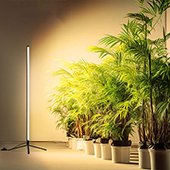Menu
Why Are Grow Lights So High in Greenhouses?
In this rapidly advancing agricultural technology era, greenhouse cultivation is no longer a novelty. It has become the secret weapon allowing us to enjoy fresh fruits and vegetables throughout the year.
In the upgraded version of this secret weapon – the high-tech greenhouse- one piece of equipment that cannot be overlooked: LED grow lights.
They are like the “artificial sun” for the plant world, providing precise and efficient light sources for our vegetables, fruits, and even precious flowers when natural sunlight is insufficient or when light cycles need regulation.
Have you ever noticed that when you enter a greenhouse, you might observe that these LED grow lights are often installed quite high, unlike the close-range illumination we use for indoor plants at home?
Are you curious like me: Why not lower the lights to shine more directly onto the plants? Wouldn’t that better to utilize the light source? What scientific principles and practical wisdom are hidden behind this?
Let’s unravel this mystery and explore why LED grow lights are installed at a relatively high position in greenhouses.
Table of Contents
Why Excessive or Insufficient Height of Lights Can Affect Overall Photosynthetic Efficiency
Consider the relationship between light intensity and distance, much like when we’re warming ourselves with a fire: the closer we are to the heat source, the warmer it feels, and vice versa.
Similarly, the light intensity emitted by LED sources gradually decreases with increasing distance from the plant surface. Hanging the lights too low may cause localized excessive light, leading to plant scorching, while hanging them too high may result in insufficient light, affecting photosynthetic efficiency.
So, what about light uniformity?
If you hang LED grow lights very low, it’s akin to shining a flashlight directly on one area of a forest; only the illuminated part receives sufficient light, leaving the rest in shadow.
In greenhouse cultivation, we aim for every leaf to receive equal treatment, ensuring overall plant health and robust development.
Therefore, the choice of installation height is to guarantee even light distribution throughout the entire plant space. Whether it’s the top leaves or the bottom seedlings, they all absorb the right amount of light energy, promoting balanced growth and enhancing both yield and quality.
Each plant relies on the miraculous process of photosynthesis to produce nutrients. The photosynthetic activity in plant leaves is not uniformly distributed on a flat plane; rather, it exhibits distinct vertical distribution characteristics.
In general, upper leaves receive more light, while lower leaves may receive less light due to obstruction.
If LED grow lights are hung too high, the lower leaves may experience reduced workloads due to insufficient light, naturally affecting the overall efficiency of photosynthesis. Conversely, if the lights are hung too low, while the lower leaves may receive sufficient light, the excessively intense illumination could lead to leaf scorching, also impacting photosynthetic efficiency.
Therefore, the light fixture’s height needs to be moderate, ensuring that all plants can efficiently produce under suitable working conditions.

The light cycle is like the biological clock for plants, requiring specific day-night rhythms to trigger different responses, such as flowering or dormancy.
In greenhouse cultivation, we can precisely control the perceived light duration (photoperiod) for plants at different growth stages by adjusting the height and on-off time of LED grow lights.
For example, certain short-day plants need shorter daylight exposure to initiate flowering. In such cases, we need to appropriately raise the height of the lights and shorten the illumination time during the night, simulating a short-day environment.
This way, the choice and adjustment of light fixture height become a secret weapon for achieving crop growth as needed, enabling our greenhouse to truly implement precision management. This not only increases yield but also ensures quality.
Greenhouse Environmental Factors and Light Fixture Height Setting
In the unique ecosystem of a greenhouse, the design of LED grow light height not only directly impacts the plant’s lighting conditions but is also closely related to other crucial environmental factors within the greenhouse.
Firstly, consider greenhouse space utilization and air circulation.
If the lights are hung too low, they may occupy valuable planting space, affecting the overall planting layout. On the other hand, an excess of lights can hinder air circulation, creating local high or low-temperature zones, which is unfavorable for even temperature and humidity distribution.
Appropriate light fixture height helps maintain good air circulation inside the greenhouse, crucial for regulating temperature, and humidity, and preventing the occurrence of diseases and pests. After all, with fresh air circulating, plants can breathe smoothly and thrive.
Secondly, concerning equipment maintenance and operational convenience, the installation height of the lights also plays a crucial role.
When the lights are closer to the ground, personnel may encounter inconveniences during daily inspections, cleaning, and adjustments. For example, lights hung too low can be obstructed by plants, making it difficult to check if the light source is functioning properly.
Additionally, fixtures too close to the ground during cleaning may splash water onto the plants, potentially leading to diseases.
If there is a need to adjust light intensity or replace damaged fixtures, a lower position can increase the difficulty of these tasks and pose safety risks.
Moderately raising the height of the lights not only avoids impacting the normal growth of plants below but also makes it more convenient for horticulturists to conduct inspections, cleaning, and necessary adjustments to light intensity.
This ensures the long-term stable operation of the facility while reducing potential risks caused by improper operation, making the overall greenhouse management more efficient and user-friendly.
Therefore, the height setting of LED grow lights in a greenhouse should not only consider the optimal light requirements for plants but also take into account the effective use of space, air circulation within the greenhouse, and the convenience of practical operational tasks.
Only with this comprehensive consideration can an ideal greenhouse environment be established that promotes efficient photosynthesis in plants and facilitates precise control for the managers.
Case Study
>> Tomato Cultivation in The Netherlands
Greenhouse: GreenTech Innovation Center, Netherlands.
Crop: Tomatoes.
Issue: Initially, inconsistent crop growth and lower yields were observed.
Adjustment: Researchers optimized LED light heights based on the specific light requirements of tomato plants at different growth stages.
Results: After the rational adjustment of LED growing light heights, there was a notable increase in overall yield and improvement in fruit quality. The scientific approach to light optimization also led to more efficient energy use within the greenhouse.
>> Lettuce Production in Japan
Greenhouse: Hokkaido Greenhouse Co., Ltd., Japan.
Crop: Hydroponic Lettuce.
Issue: Uneven growth and suboptimal quality of lettuce leaves.
Adjustment: LED plant light heights were systematically adjusted to ensure uniform light distribution across the entire crop canopy.
Results: Following the adjustments, there was a significant improvement in both yield and quality. The lettuce heads exhibited more consistent growth, reduced instances of disease, and enhanced nutritional content due to the optimized light exposure.
>> Strawberry Farming in California, USA
Greenhouse: Silicon Valley AgroTech, California, USA.
Crop: Hydroponic Strawberries.
Issue: Insufficient fruit production and inconsistent berry size.
Adjustment: LED light heights were adjusted based on the growth stage of strawberries, emphasizing the need for higher light intensity during the flowering and fruiting phases.
Results: The rational setting of LED grow light heights resulted in improved pollination, increased flower production, and larger, more uniform strawberries. This approach not only enhanced yield but also positively impacted the market value of the strawberries.
Get in touch with us!
From custom light planning, to tailored quotes, and everything in between, our team of horticulture experts are always ready to assist.




